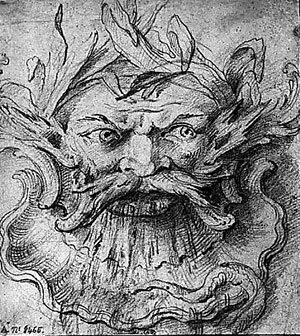


If you want to use this picture, please contact our library
Composed of a mosaic of medallions and compartments intwined with arabesques, this decor is inspired by the Parisian interiors of the 1710s and 1720s. Its geometric framework teems with a fanciful, even fantastic decorative array of chimera, fauns’ heads and acanthus leaves. Some of these elements evoke Louis XIV decoration while others foreshadow the rococo style that flourished in Louis XV’s reign. The ceiling, with its central medallion decorated with cherubs on a sky-blue ground and recessed panels painted with arabesques on a gold ground, also shows the transition between the two styles.

The bearded fauns’ heads and winged chimera in the mascarons are imaginary creatures originating in Antiquity, frequently depicted in art and decoration down the centuries.
The faces surrounded by garlands of laurels and other plants are derived from the Louis XIV decorative repertoire and often features of the gilt bronze decoration of furniture and clocks, for example on the creations of Louis XIV’s famous cabinetmaker, André-Charles Boulle.
Comme le montrent ces deux exemples de têtes de faune légèrement différentes l’une de l’autre, chaque ornement est conçu et réalisé comme un unicum.
A droite, l’un des visages sculptés de la boiserie ; à côté, trois exemples de bronzes d’applique des collections du musée des Arts décoratifs (inv. 23769.A, 24553.A, PR 2009.2.5-1) offrant des déclinaisons variées autour de ce motif de visage.
The sculpted ornamentation of the panelling is also composed of vases, cassolettes and profile portrait medallions reminiscent of cameos, painted motifs typical of the antique ornamental repertoire. Combined with hybrid figures, flower garlands, parasols and coils, they create a decor of arabesques also originating in Antiquity. Allowing free rein to fantasy and imagination, arabesques were an enduringly popular decorative theme employed with great variety from the 16th to the 19th century.
On retrouve dans ce projet de plafond dessiné par Claude III Audran au début du XVIIIe siècle (inv. 8483, à gauche), le même décor d’arabesques que sur les murs et le plafond du cabinet (détail à droite)
On the other hand, the shells, palm leaves, acanthus leaves and flowers are typical of rococo, the style, inspired by the forms of nature, that emerged in the first half of Louis XV’s reign. Joiners reinterpreted these motifs in sculpted wood on wainscoting, chairs and armchairs, and cabinetmakers and clockmakers used them to decorate furniture (chests of drawers, desks) and clocks with gilt bronze.
Parmi les motifs sculptés de la boiserie se trouvent des ornements tirés de la nature et chers à l’ornementation rocaille : coquilles, fleurs, palmes et feuilles d’acanthe.